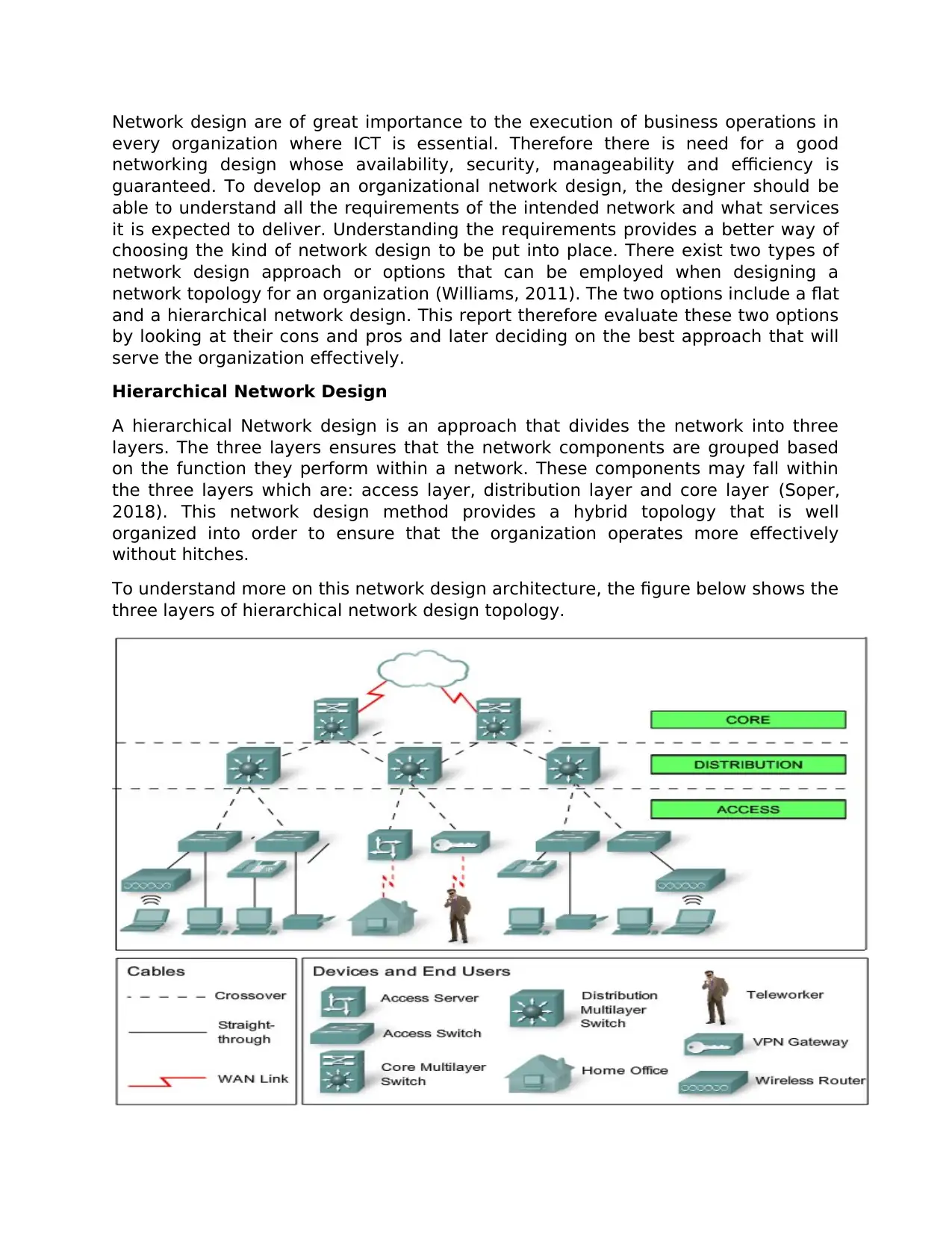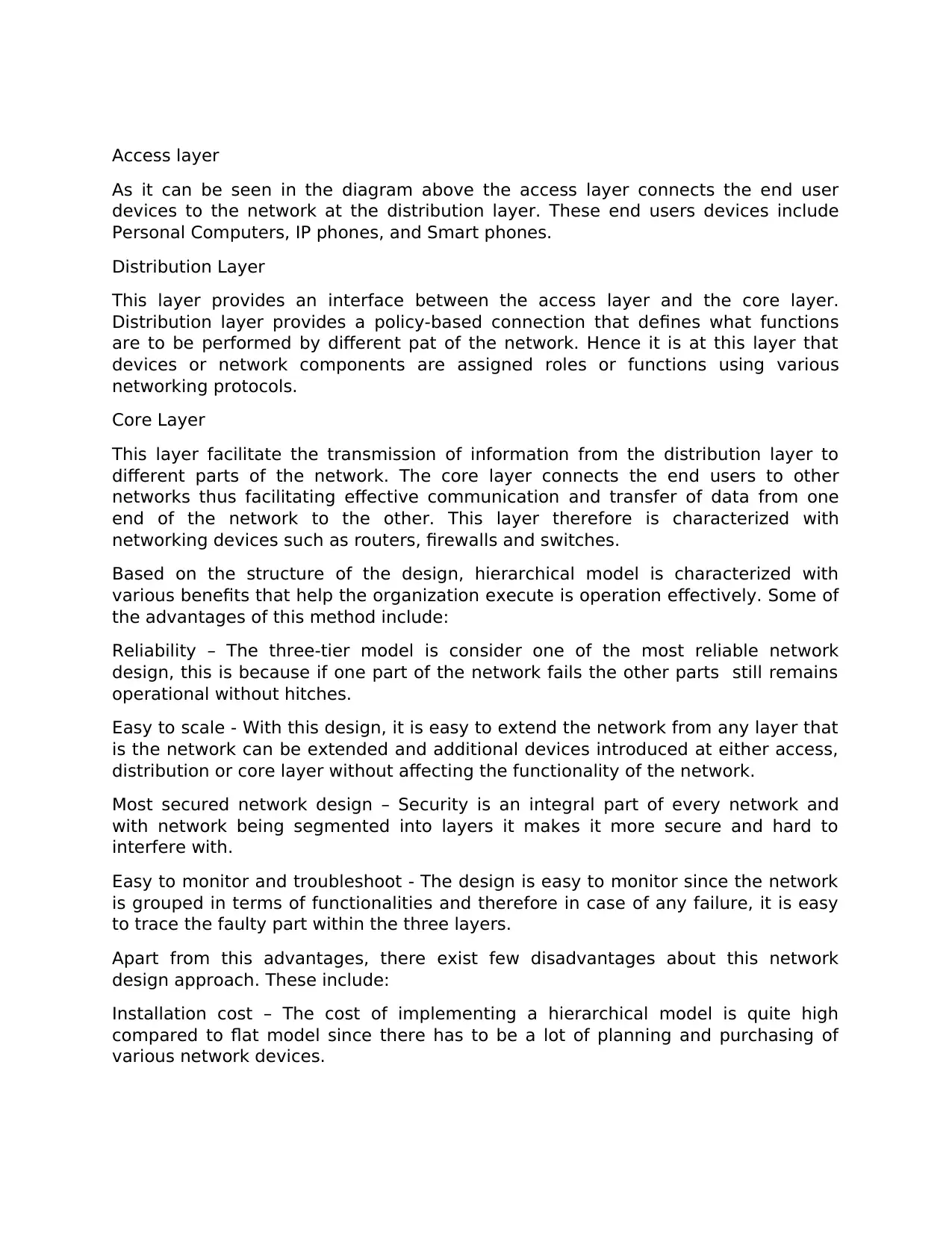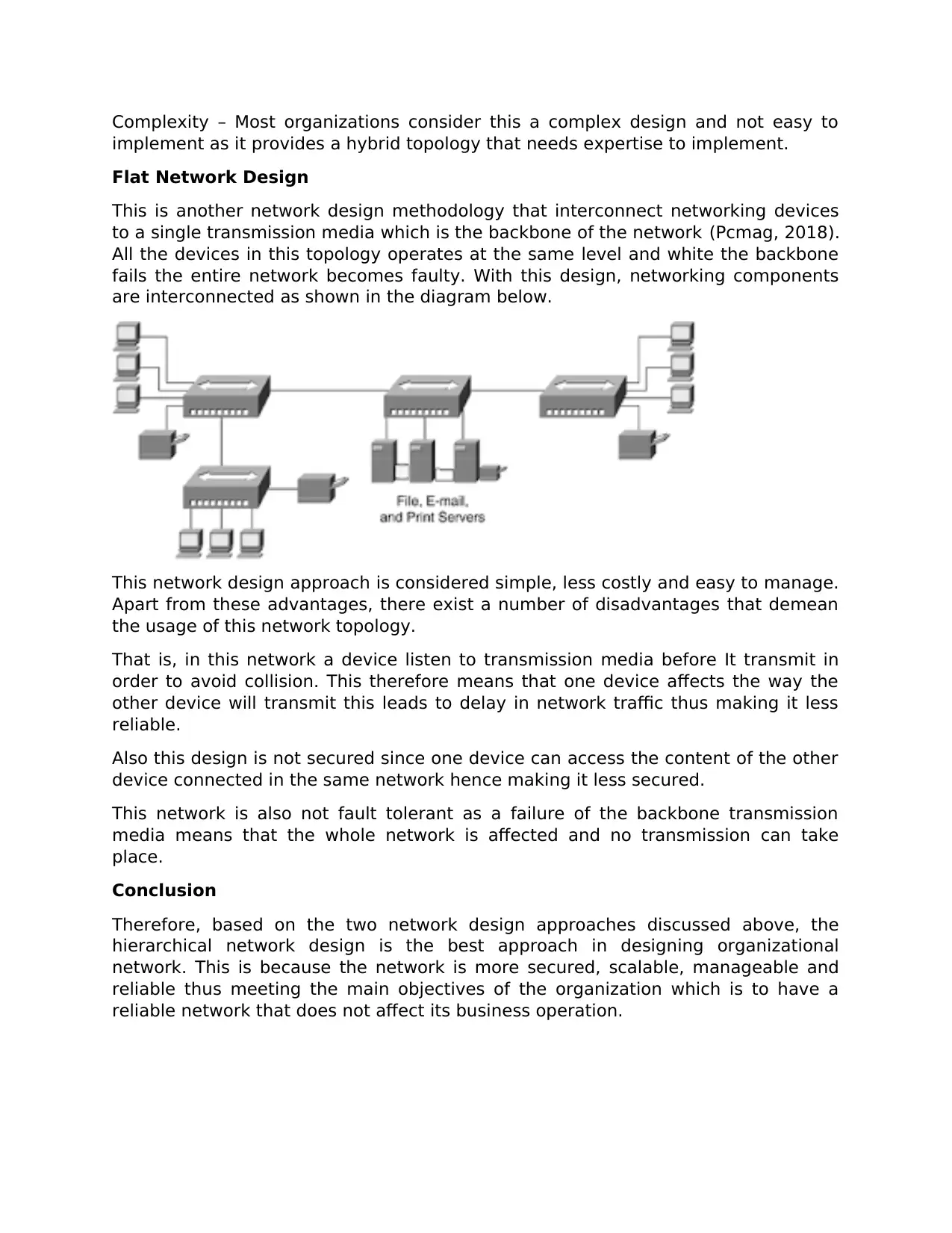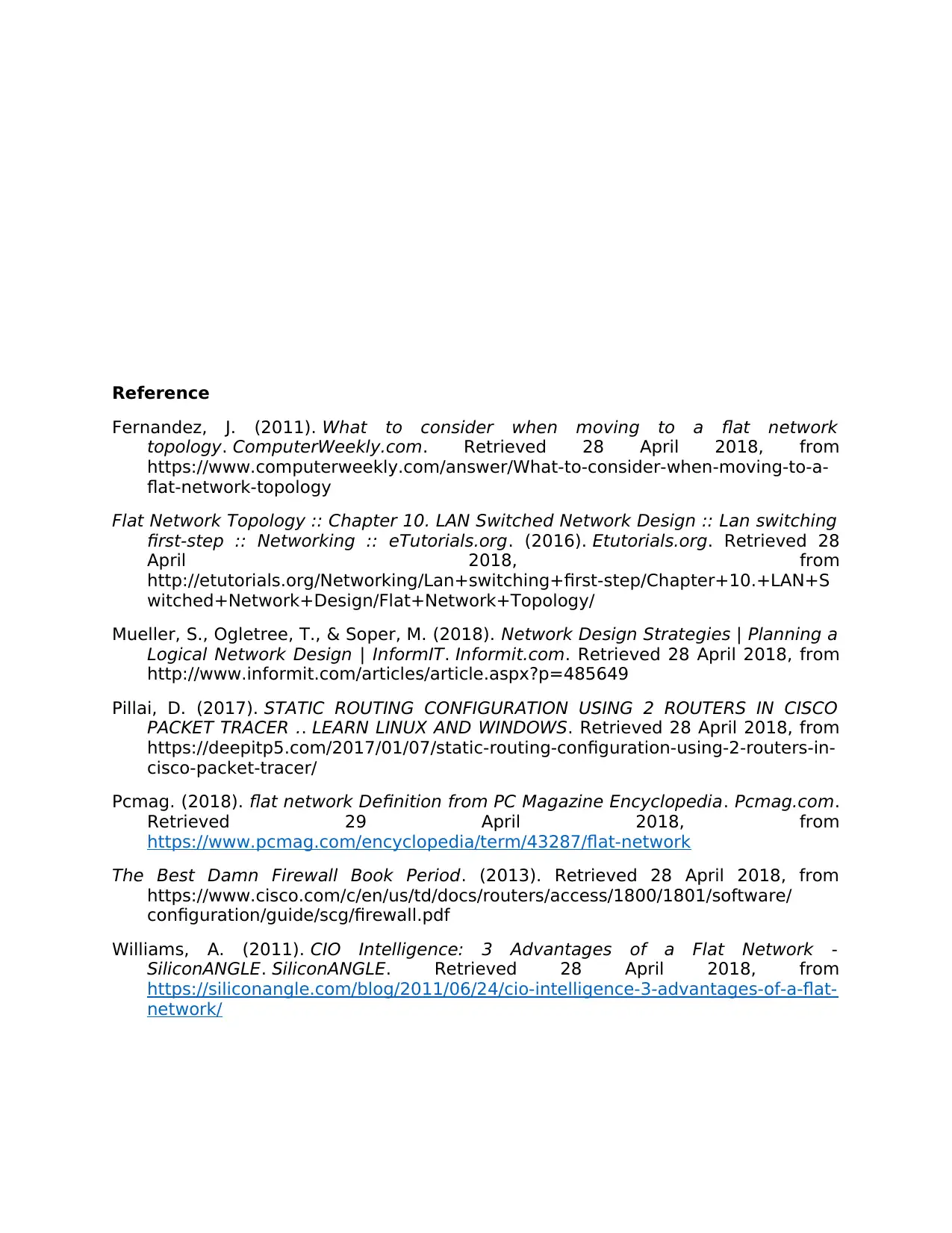Comparative Analysis of Network Design Methods for Organizations
VerifiedAdded on 2021/06/16
|6
|1191
|34
Report
AI Summary
This report evaluates two primary network design approaches: flat and hierarchical. The report begins by emphasizing the importance of robust network design for organizational ICT operations, highlighting the need for availability, security, manageability, and efficiency. The core of the report delves into the characteristics of both network design methodologies. The hierarchical design is presented as a three-layered architecture (access, distribution, and core layers), detailing the functions and components within each layer and its advantages, including reliability, scalability, security, and ease of troubleshooting. Conversely, the flat network design is described as a simpler, single-layer approach, outlining its cost-effectiveness and ease of management but also its limitations in terms of security, fault tolerance, and potential for network congestion. The report concludes by advocating for the hierarchical network design as the superior choice for organizational networks due to its enhanced security, scalability, manageability, and reliability, thereby supporting the organization's operational objectives effectively. The report references several sources to support the analysis.

Network Design Methods
Student Name
Institution
Introduction
Student Name
Institution
Introduction
Paraphrase This Document
Need a fresh take? Get an instant paraphrase of this document with our AI Paraphraser

Network design are of great importance to the execution of business operations in
every organization where ICT is essential. Therefore there is need for a good
networking design whose availability, security, manageability and efficiency is
guaranteed. To develop an organizational network design, the designer should be
able to understand all the requirements of the intended network and what services
it is expected to deliver. Understanding the requirements provides a better way of
choosing the kind of network design to be put into place. There exist two types of
network design approach or options that can be employed when designing a
network topology for an organization (Williams, 2011). The two options include a flat
and a hierarchical network design. This report therefore evaluate these two options
by looking at their cons and pros and later deciding on the best approach that will
serve the organization effectively.
Hierarchical Network Design
A hierarchical Network design is an approach that divides the network into three
layers. The three layers ensures that the network components are grouped based
on the function they perform within a network. These components may fall within
the three layers which are: access layer, distribution layer and core layer (Soper,
2018). This network design method provides a hybrid topology that is well
organized into order to ensure that the organization operates more effectively
without hitches.
To understand more on this network design architecture, the figure below shows the
three layers of hierarchical network design topology.
every organization where ICT is essential. Therefore there is need for a good
networking design whose availability, security, manageability and efficiency is
guaranteed. To develop an organizational network design, the designer should be
able to understand all the requirements of the intended network and what services
it is expected to deliver. Understanding the requirements provides a better way of
choosing the kind of network design to be put into place. There exist two types of
network design approach or options that can be employed when designing a
network topology for an organization (Williams, 2011). The two options include a flat
and a hierarchical network design. This report therefore evaluate these two options
by looking at their cons and pros and later deciding on the best approach that will
serve the organization effectively.
Hierarchical Network Design
A hierarchical Network design is an approach that divides the network into three
layers. The three layers ensures that the network components are grouped based
on the function they perform within a network. These components may fall within
the three layers which are: access layer, distribution layer and core layer (Soper,
2018). This network design method provides a hybrid topology that is well
organized into order to ensure that the organization operates more effectively
without hitches.
To understand more on this network design architecture, the figure below shows the
three layers of hierarchical network design topology.

Access layer
As it can be seen in the diagram above the access layer connects the end user
devices to the network at the distribution layer. These end users devices include
Personal Computers, IP phones, and Smart phones.
Distribution Layer
This layer provides an interface between the access layer and the core layer.
Distribution layer provides a policy-based connection that defines what functions
are to be performed by different pat of the network. Hence it is at this layer that
devices or network components are assigned roles or functions using various
networking protocols.
Core Layer
This layer facilitate the transmission of information from the distribution layer to
different parts of the network. The core layer connects the end users to other
networks thus facilitating effective communication and transfer of data from one
end of the network to the other. This layer therefore is characterized with
networking devices such as routers, firewalls and switches.
Based on the structure of the design, hierarchical model is characterized with
various benefits that help the organization execute is operation effectively. Some of
the advantages of this method include:
Reliability – The three-tier model is consider one of the most reliable network
design, this is because if one part of the network fails the other parts still remains
operational without hitches.
Easy to scale - With this design, it is easy to extend the network from any layer that
is the network can be extended and additional devices introduced at either access,
distribution or core layer without affecting the functionality of the network.
Most secured network design – Security is an integral part of every network and
with network being segmented into layers it makes it more secure and hard to
interfere with.
Easy to monitor and troubleshoot - The design is easy to monitor since the network
is grouped in terms of functionalities and therefore in case of any failure, it is easy
to trace the faulty part within the three layers.
Apart from this advantages, there exist few disadvantages about this network
design approach. These include:
Installation cost – The cost of implementing a hierarchical model is quite high
compared to flat model since there has to be a lot of planning and purchasing of
various network devices.
As it can be seen in the diagram above the access layer connects the end user
devices to the network at the distribution layer. These end users devices include
Personal Computers, IP phones, and Smart phones.
Distribution Layer
This layer provides an interface between the access layer and the core layer.
Distribution layer provides a policy-based connection that defines what functions
are to be performed by different pat of the network. Hence it is at this layer that
devices or network components are assigned roles or functions using various
networking protocols.
Core Layer
This layer facilitate the transmission of information from the distribution layer to
different parts of the network. The core layer connects the end users to other
networks thus facilitating effective communication and transfer of data from one
end of the network to the other. This layer therefore is characterized with
networking devices such as routers, firewalls and switches.
Based on the structure of the design, hierarchical model is characterized with
various benefits that help the organization execute is operation effectively. Some of
the advantages of this method include:
Reliability – The three-tier model is consider one of the most reliable network
design, this is because if one part of the network fails the other parts still remains
operational without hitches.
Easy to scale - With this design, it is easy to extend the network from any layer that
is the network can be extended and additional devices introduced at either access,
distribution or core layer without affecting the functionality of the network.
Most secured network design – Security is an integral part of every network and
with network being segmented into layers it makes it more secure and hard to
interfere with.
Easy to monitor and troubleshoot - The design is easy to monitor since the network
is grouped in terms of functionalities and therefore in case of any failure, it is easy
to trace the faulty part within the three layers.
Apart from this advantages, there exist few disadvantages about this network
design approach. These include:
Installation cost – The cost of implementing a hierarchical model is quite high
compared to flat model since there has to be a lot of planning and purchasing of
various network devices.
⊘ This is a preview!⊘
Do you want full access?
Subscribe today to unlock all pages.

Trusted by 1+ million students worldwide

Complexity – Most organizations consider this a complex design and not easy to
implement as it provides a hybrid topology that needs expertise to implement.
Flat Network Design
This is another network design methodology that interconnect networking devices
to a single transmission media which is the backbone of the network (Pcmag, 2018).
All the devices in this topology operates at the same level and white the backbone
fails the entire network becomes faulty. With this design, networking components
are interconnected as shown in the diagram below.
This network design approach is considered simple, less costly and easy to manage.
Apart from these advantages, there exist a number of disadvantages that demean
the usage of this network topology.
That is, in this network a device listen to transmission media before It transmit in
order to avoid collision. This therefore means that one device affects the way the
other device will transmit this leads to delay in network traffic thus making it less
reliable.
Also this design is not secured since one device can access the content of the other
device connected in the same network hence making it less secured.
This network is also not fault tolerant as a failure of the backbone transmission
media means that the whole network is affected and no transmission can take
place.
Conclusion
Therefore, based on the two network design approaches discussed above, the
hierarchical network design is the best approach in designing organizational
network. This is because the network is more secured, scalable, manageable and
reliable thus meeting the main objectives of the organization which is to have a
reliable network that does not affect its business operation.
implement as it provides a hybrid topology that needs expertise to implement.
Flat Network Design
This is another network design methodology that interconnect networking devices
to a single transmission media which is the backbone of the network (Pcmag, 2018).
All the devices in this topology operates at the same level and white the backbone
fails the entire network becomes faulty. With this design, networking components
are interconnected as shown in the diagram below.
This network design approach is considered simple, less costly and easy to manage.
Apart from these advantages, there exist a number of disadvantages that demean
the usage of this network topology.
That is, in this network a device listen to transmission media before It transmit in
order to avoid collision. This therefore means that one device affects the way the
other device will transmit this leads to delay in network traffic thus making it less
reliable.
Also this design is not secured since one device can access the content of the other
device connected in the same network hence making it less secured.
This network is also not fault tolerant as a failure of the backbone transmission
media means that the whole network is affected and no transmission can take
place.
Conclusion
Therefore, based on the two network design approaches discussed above, the
hierarchical network design is the best approach in designing organizational
network. This is because the network is more secured, scalable, manageable and
reliable thus meeting the main objectives of the organization which is to have a
reliable network that does not affect its business operation.
Paraphrase This Document
Need a fresh take? Get an instant paraphrase of this document with our AI Paraphraser

Reference
Fernandez, J. (2011). What to consider when moving to a flat network
topology. ComputerWeekly.com. Retrieved 28 April 2018, from
https://www.computerweekly.com/answer/What-to-consider-when-moving-to-a-
flat-network-topology
Flat Network Topology :: Chapter 10. LAN Switched Network Design :: Lan switching
first-step :: Networking :: eTutorials.org. (2016). Etutorials.org. Retrieved 28
April 2018, from
http://etutorials.org/Networking/Lan+switching+first-step/Chapter+10.+LAN+S
witched+Network+Design/Flat+Network+Topology/
Mueller, S., Ogletree, T., & Soper, M. (2018). Network Design Strategies | Planning a
Logical Network Design | InformIT. Informit.com. Retrieved 28 April 2018, from
http://www.informit.com/articles/article.aspx?p=485649
Pillai, D. (2017). STATIC ROUTING CONFIGURATION USING 2 ROUTERS IN CISCO
PACKET TRACER .. LEARN LINUX AND WINDOWS. Retrieved 28 April 2018, from
https://deepitp5.com/2017/01/07/static-routing-configuration-using-2-routers-in-
cisco-packet-tracer/
Pcmag. (2018). flat network Definition from PC Magazine Encyclopedia. Pcmag.com.
Retrieved 29 April 2018, from
https://www.pcmag.com/encyclopedia/term/43287/flat-network
The Best Damn Firewall Book Period. (2013). Retrieved 28 April 2018, from
https://www.cisco.com/c/en/us/td/docs/routers/access/1800/1801/software/
configuration/guide/scg/firewall.pdf
Williams, A. (2011). CIO Intelligence: 3 Advantages of a Flat Network -
SiliconANGLE. SiliconANGLE. Retrieved 28 April 2018, from
https://siliconangle.com/blog/2011/06/24/cio-intelligence-3-advantages-of-a-flat-
network/
Fernandez, J. (2011). What to consider when moving to a flat network
topology. ComputerWeekly.com. Retrieved 28 April 2018, from
https://www.computerweekly.com/answer/What-to-consider-when-moving-to-a-
flat-network-topology
Flat Network Topology :: Chapter 10. LAN Switched Network Design :: Lan switching
first-step :: Networking :: eTutorials.org. (2016). Etutorials.org. Retrieved 28
April 2018, from
http://etutorials.org/Networking/Lan+switching+first-step/Chapter+10.+LAN+S
witched+Network+Design/Flat+Network+Topology/
Mueller, S., Ogletree, T., & Soper, M. (2018). Network Design Strategies | Planning a
Logical Network Design | InformIT. Informit.com. Retrieved 28 April 2018, from
http://www.informit.com/articles/article.aspx?p=485649
Pillai, D. (2017). STATIC ROUTING CONFIGURATION USING 2 ROUTERS IN CISCO
PACKET TRACER .. LEARN LINUX AND WINDOWS. Retrieved 28 April 2018, from
https://deepitp5.com/2017/01/07/static-routing-configuration-using-2-routers-in-
cisco-packet-tracer/
Pcmag. (2018). flat network Definition from PC Magazine Encyclopedia. Pcmag.com.
Retrieved 29 April 2018, from
https://www.pcmag.com/encyclopedia/term/43287/flat-network
The Best Damn Firewall Book Period. (2013). Retrieved 28 April 2018, from
https://www.cisco.com/c/en/us/td/docs/routers/access/1800/1801/software/
configuration/guide/scg/firewall.pdf
Williams, A. (2011). CIO Intelligence: 3 Advantages of a Flat Network -
SiliconANGLE. SiliconANGLE. Retrieved 28 April 2018, from
https://siliconangle.com/blog/2011/06/24/cio-intelligence-3-advantages-of-a-flat-
network/

⊘ This is a preview!⊘
Do you want full access?
Subscribe today to unlock all pages.

Trusted by 1+ million students worldwide
1 out of 6
Related Documents
Your All-in-One AI-Powered Toolkit for Academic Success.
+13062052269
info@desklib.com
Available 24*7 on WhatsApp / Email
![[object Object]](/_next/static/media/star-bottom.7253800d.svg)
Unlock your academic potential
Copyright © 2020–2025 A2Z Services. All Rights Reserved. Developed and managed by ZUCOL.




![Network Design Methods for TEMAOS - Assessment 3 - [University Name]](/_next/image/?url=https%3A%2F%2Fdesklib.com%2Fmedia%2Fimages%2Fcs%2F077596fabd9840ffa52d8bc0a9d40c24.jpg&w=256&q=75)
